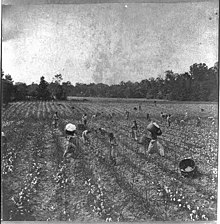Federal Writers' Project – Life Histories/2019/Fall/Section 1/Henry Baysmore
Henry Baysmore
[edit | edit source]Federal Writers' Project – Life Histories/2019/Fall/Section 1/Henry Baysmore | |
|---|---|
 | |
| Born | Henry White (alleged) |
| Nationality | American |
| Occupation | Fortune teller |
| Spouse(s) | Unnamed woman |
| Children | Two daughters, unnamed |
Overview
[edit | edit source]Henry Baysmore was a 74-year-old fortune teller living in Montgomery, Alabama when he was interviewed by Adelaide Rogers.
Biography
[edit | edit source]Early Life
[edit | edit source]Very little is known about Baysmore’s early life, but his neighbors speculated to Rogers that he came from Texas, leaving behind a very troubled life. Baysmore was married and had two daughters, but, at the time of his interview, had been a widower for 20 years and was leaving almost all of his earthly possessions to his “oldest an’ bes’ daughter.” [1]
Later Life
[edit | edit source]Baysmore worked as a sharecropper for a time before leaving this line of work to become a fortune teller. Baysmore considered becoming a preacher, but instead he studied under a “gipsy” [2] to learn how to perform seances and read from crystals. His neighbors also claim that he was married to a young woman who had married twice before, but Baysmore himself denied these claims, saying “Tongue waggin’ is de cheapest an’ mos’ usefulmess spo’te dey is.” [3]
Social Issues
[edit | edit source]Fortune Telling and Race during the Great Depression
[edit | edit source]Fortune telling as a profession was actually illegal during the Great Depression. These regulations started tightening in the 1920s and by the 1930s, operations were underway to arrest fortune tellers. [4] However, options for employment were limited, as black individuals were still heavily discriminated against during this time period. In fact, many black people were self-employed as government jobs prioritized white people. [5] “The analysis shows that among persons looking for work two years or more, blacks' unemployment is positively associated with the odds of self-employment, whereas whites' unemployment is positively associated with the odds of public emergency work,” states Robert L. Boyd in his study for Sociological Focus. Others turned to sharecropping, which proved to be incredibly inefficient and still is when used today, even in experimental trials. [6]
Religion during the Great Depression
[edit | edit source]Religion was an important crutch for many during the Great Depression. Citizens would often turn to their faith to explain the economic downfall. In the end, it was attributed to karma, and was considered to be a punishment for past actions. The Great Depression had to be endured, otherwise the environment would never return to normal. [7] Many relied on their religion because it provided something to look forward to, even if that something was the gates of Heaven. The justification of others' suffering led to a continuation of this vicious cycle - the rich, who seemed to most obviously have the power to "fix" the situation, did nothing because they believed it would all be over soon enough.
Music during the Great Depression
[edit | edit source]Similarly, music became very important during the Great Depression. From this era, many popular styles were born, most notably jazz and blues. Music served as an outlet for people to complain about the hardships of life or even to hope for better days. [8] Songs of the time were used as distractors. Basymore’s favorite song was “Nobody Knows the Trouble I’ve Seen.” He said that he “never listens no mo’ to darkies sing” [9] because his time as a sharecropper allowed him to hear enough singing from black people. The Great Depression’s music was mostly pioneered by black people; this led to more of a white interest in performances, as noted by Baysmore when he said “white folks fall over each other goin’ to hear de Jubilee Singers Swing Low in dey Sweet Chariots.” [10]
References
[edit | edit source]- ↑ Rogers, Adelaide. n.d. “Gab’ul, Chune Dat Hap!” Federal Writers Project Papers. 1936-1940. The Wilson Library, The University of North Carolina at Chapel Hill.
- ↑ Ibid
- ↑ Ibid
- ↑ Ewbank, Anne. 2017. “The New York Tea Room Raids That Targeted Illicit Fortune Telling.” Atlas Obscura. Atlas Obscura. December 8, 2017. https://www.atlasobscura.com/articles/tea-room-police-raids-new-york-psychics-fortune-telling.
- ↑ Boyd, Robert L. 2017. “Self-Employment or Government Work? Blacks’ and Whites’ Responses to Long-Term Joblessness during the Great Depression.” Sociological Focus51 (2): 150–67. https://doi.org/10.1080/00380237.2017.1368311.
- ↑ Kemper, Niels, Kristina Czura, and Heiner Schumacher. 2018. “Unfair Incentives: A Behavioural Note on Sharecropping.” Economics of Transition26 (2): 303–31. https://doi.org/10.1111/ecot.12146.
- ↑ Marsh, John. 2016. “Purging the Rottenness from the System: The Blessed and the Damned in the Great Depression.” Arizona Quarterly: A Journal of American Literature, Culture, and Theory72 (2): 121–46. https://doi.org/10.1353/arq.2016.0007.
- ↑ “Songs of the Great Depression and the Dust Bowl Migrants.” n.d. The Library of Congress. The Library of Congress. Accessed November 19, 2019. https://www.loc.gov/item/ihas.200197402/.
- ↑ Ibid
- ↑ Ibid